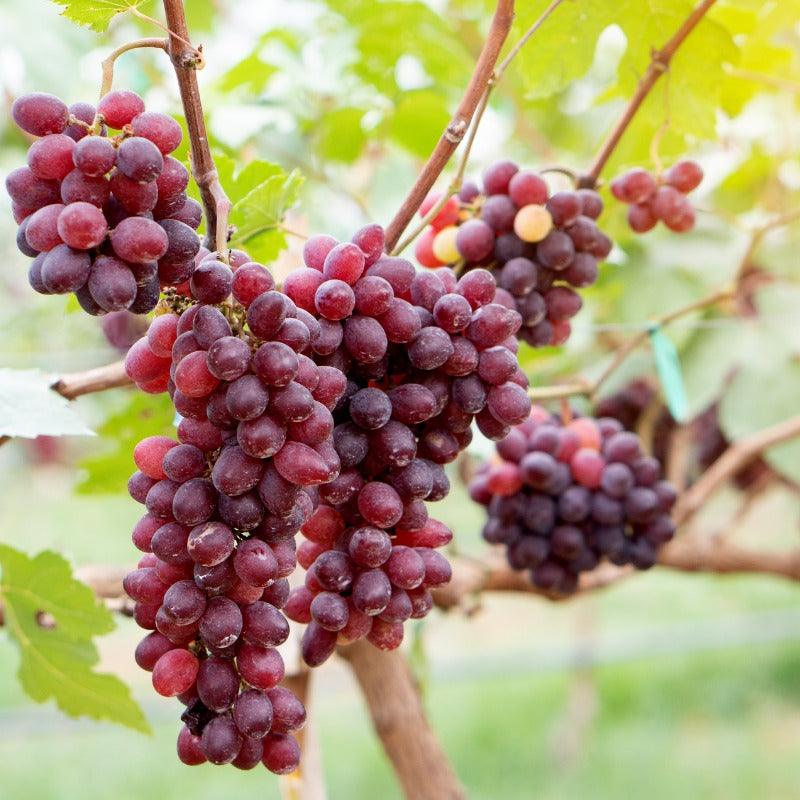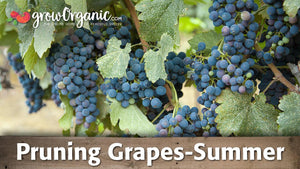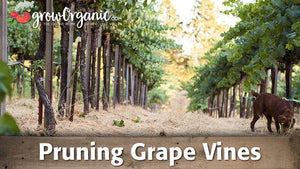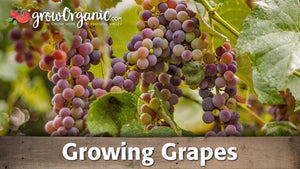Item Number: FV013
Crimson Seedless Table Grape Vine
Bright red grapes, sweet and crisp.
Mix-and-match for free shipping when purchasing 6 or more perennial berries, vines, or crowns! Crimson Seedless grapes are a late-season favorite, celebrated for their firm texture, bright red color, and sweet flavor. These versatile crimson grapes are ideal for fresh eating, snacking, or mixing into fruit salads. Thriving in full sun and well-drained soil, the crimson seedless grape vine for sale at Grow Organic is both vigorous and productive, offering reliable harvests of long-lasting fruit. With excellent shelf life, striking visual appeal, and outstanding taste, crimson seedless grapes are a top pick for home gardeners and commercial growers alike.
- Bare Root Vine
- Variety: American
- Zones: 6-10
- Pruning: Cane or spur Prune
- Harvest: September - October
- Fruit: Bright Red, medium-sized oval fruit with translucent flesh
- Facts of note: Crisp, juicy texture, tart but sweet flavor. Excellent shelf life.
Crimson Seedless grapes are a popular variety of table grapes known for their vibrant red skin, medium-sized oval shape, and crisp texture. With a balance of tart and sweet flavors, these grapes are a favorite for snacking and adding to various dishes. They are prized for their excellent shelf life, making them an ideal option for home gardens and commercial vineyards alike. Growing Crimson Seedless grapes can be a rewarding endeavor for anyone interested in producing high-quality fruit that is both visually appealing and delicious.
Growing Grapes: Crimson Seedless Grape Vine
The crimson seedless grape vine for sale thrives in USDA hardiness zone 6–10, where warm, sunny climates support optimal growth. To produce top-quality crimson seedless grapes, plant vines in full sun—at least 6 to 8 hours daily—in well-drained, loamy soil rich in organic matter. Good drainage is key, as waterlogged soil can cause root rot. Spacing vines 6 to 8 feet apart improves air circulation and helps prevent disease, ensuring vigorous plants and abundant harvests of flavorful crimson grapes.
Grape Pruning for Crimson Seedless
Pruning is essential for growing high-quality crimson seedless grapes, as it boosts yield and fruit quality. Whether using cane or spur methods, prune the crimson seedless grape vine for sale during dormancy—late winter or early spring—to remove old wood and focus energy on fruiting canes. Training vines on a sturdy trellis improves airflow and supports heavy clusters of crimson grapes, helping reduce disease and ensuring a productive harvest.
Watering and Fertilizing Crimson Seedless Grapes
To grow healthy crimson seedless grapes, consistent deep watering is key—keep soil moist but not saturated to avoid root rot. Early morning watering and drip irrigation help reduce disease risk. As crimson grapes ripen, monitor moisture closely to maintain fruit quality and yield. Fertilize the crimson seedless grape vine for sale with a balanced mix of nitrogen, phosphorus, and potassium in early spring and midsummer, avoiding excess nitrogen that can reduce fruit quality.
Managing Pests and Diseases
Crimson Seedless grapevines, like other grape varieties, are susceptible to a range of pests and diseases that can affect fruit production. Common pests include grape leafhoppers, spider mites, and aphids, which can feed on the foliage and reduce the vine's vigor. Natural predators, such as ladybugs, can help control these pests, and insecticidal soaps or horticultural oils can be used if pest populations become problematic.
Fungal diseases, including powdery mildew, downy mildew, and botrytis bunch rot, are also common in grapevines. These diseases can cause damage to the leaves, stems, and grape clusters, reducing the overall yield and fruit quality. Powdery mildew appears as a white, powdery coating on the leaves and fruit, while downy mildew causes yellow spots on the leaves. Botrytis bunch rot affects the grape clusters, leading to shriveled or rotting fruit.
To minimize the risk of fungal infections, ensure that your vines have good air circulation by spacing them properly and training them on a trellis. Regularly inspect the vines for signs of disease, and apply fungicides or organic sulfur-based sprays as needed to prevent outbreaks. Avoid overhead watering, as wet foliage can promote the spread of fungal diseases.
Harvesting Grapes: Crimson Seedless
The harvest period for Crimson Seedless grapes typically falls between September and October, depending on the climate and growing conditions. These grapes are known for their bright red skin and translucent flesh, and they should be harvested when fully ripe to ensure the best flavor and texture.
To determine when the grapes are ready for harvest, taste a few from different clusters. They should have a balance of sweetness and tartness, with a crisp, juicy texture. The grapes will not continue to ripen once picked, so it’s important to harvest them at their peak ripeness.
When harvesting, use clean, sharp pruning shears to cut the clusters from the vine. Handle the grapes carefully to avoid bruising or damaging the fruit, as this can reduce their shelf life and overall quality. Once harvested, Crimson Seedless grapes can be stored in the refrigerator for several days, though they are best enjoyed fresh.
Uses of Crimson Seedless Grapes
Crimson Seedless grapes are primarily grown as table grapes, valued for their bright color, juicy texture, and sweet-tart flavor. Their excellent shelf life makes them ideal for storing and snacking, and they can be used in a variety of culinary applications. Whether enjoyed on their own, added to fruit salads, or used as a garnish for desserts, these grapes bring a refreshing burst of flavor to any dish.
While Crimson Seedless grapes are not typically used for wine production, they are highly sought after for their use in fresh markets and home gardens. Their attractive appearance and long shelf life make them a favorite among consumers, and they are often included in fruit platters and salads.
Conclusion
Growing Crimson Seedless grapes offers an excellent opportunity to enjoy high-quality table grapes with a beautiful red color, crisp texture, and delicious flavor. With proper care, including careful pruning, consistent watering, and pest management, these vines will produce abundant fruit that is perfect for fresh eating and culinary use. Whether you’re a backyard gardener or a commercial grower, the Crimson Seedless grape vine is a versatile and rewarding variety to cultivate, offering sweet, juicy Crimson Seedless grapes with a long shelf life.
Visit our Berry, Vine & Crowns Characteristics Chart to compare growing characteristics for all our berries, vines, and crowns.




Check Your Zone Compatibility:
Compatible with your zone.
Growing Zone for

Our Guarantee To You
Since 1976, we've served our customers at every stage of growing. Please contact us at any time. We are happy to support and assist you.
Shipping Information
Shipping Information
Cannot ship to the following states: HI , AK , PR , GU , VI , OR , WA , ID
Cannot ship via USPS.
Cannot ship via SmartPost.
Shipping Weight: 3.3 lb
Dimensions: 36.0"L x 4.0"W x 4.0"H
Features
Features
Characteristics
Characteristics
Planting & Care
Planting & Care
Useful Information
Useful Information
Guarantee
Guarantee
Limited Dormant Tree & Plant Guarantee
* Claim deadline is June 15th
We guarantee that your dormant tree or plant will arrive in good, viable condition. If your tree arrives in substandard condition, notify us within 3 days of delivery. Please email pictures of the box, inside packaging, the tree and its roots to helpdesk@groworganic.com. We will investigate your claim and process a request to exchange or refund the damaged product.
If your dormant tree or plant has not grown new leaves by June 15th, you may be eligible for our Limited Dormant Tree & Plant Guarantee. This guarantee provides for a store credit for the purchase price of the tree, excluding shipping. Please see the Instructions below.
Important Dates:
- April 1st Dormant trees/plants must be planted in the ground
- May 15th Perform scratch test, if no new leaves have grown
- June 15th Deadline to apply for a dormant tree/plant credit
All required documentation must be received by June 15th for your claim to be considered. Claims or documentation received after June 15th will be denied, without exception. Instructions listed below
Terms and Conditions
We cannot guarantee that your tree or plant will remain alive and healthy after it is received, or bear fruit as there are too many variables in your environment that are beyond our control (i.e. soil preparation, weed and pest control, proper irrigation, chill hours, compatible hardiness for your growing zone, proper choice of pollinator, extreme weather, rodent damage, disease, etc.).
We cannot guarantee that we will be able to provide a replacement tree/plant of the same species either that same growing season or in future years. Customers are responsible for all shipping fees associated with replacement trees and plants.
If we determine that the tree you purchased directly from us is not viable, we will issue you a store credit (not a refund) for the purchase price of the affected dormant tree or plant. Shipping is not included in the dormant tree/plant guarantee. Store credits can be used to purchase any product we sell and are valid for use only until July 1st of the following year.
Historically, 98% of our dormant trees and plants grow and thrive when they have been cared for and planted using our growing guides. Dormant trees and plants must be planted in the ground by April 1st in order to be eligible for credit. If the ground in your area is still frozen solid, you may temporarily plant your tree or plant in a pot.
Potted, non-dormant trees or plants are excluded from this guarantee as they are not dormant at the time of shipment. Evergreen trees such as citrus, avocado and olive trees are not available for credit under the Dormant Tree and Plant Guarantee.
Instructions
We guarantee that your dormant fruit tree or plant will leaf out, if you care for it according to our growing guides. In the unlikely event that your dormant tree or plant does not have leaves by May 15th, follow these simple steps to apply for a store credit:
Before you call or email, please perform a “scratch test” to determine if the tree or plant is still alive. This video shows how to check for live tissue under the bark. Scratch tests need to be done a few inches above and below the graft.
Green Cambium Layer / Living Trees
If the cambium layer under the bark is green, give your tree a little more time. It is still alive, but hasn’t come out of dormancy yet. Check to make sure that it is getting the right amount of deep root water, enough sunlight and that the weather is warm enough for that type of tree/plant to come out of dormancy. Every tree has its own personality and will come out of dormancy at different times. Be sure to submit the required documentation listed below by June 15th, if it doesn’t grow leaves.
Brown Cambium Layer / Dead Trees
If the scratch test shows a brown cambium layer or if your dormant tree/plant doesn’t have leaves by June 1st, please email us at helpdesk@groworganic.com. All required documentation listed below must be received by June 15th for your claim to be considered. To be considered for the guarantee claim, all required documentation must be received by June 15th. Incomplete submissions will be denied.
Required Documentation
- Order number
- Name of dormant tree/plant and the quantity affected
- Photos of each tree or plant showing:
- The roots (tree or plant must be pulled out of the ground)
- The scratch test areas
- The entire tree/plant
We reserve the right to not issue credit for items that have already been replaced. We also reserve the right to require photographic evidence that the tree/plant was not killed by root rot, rodent or mechanical damage.
Share
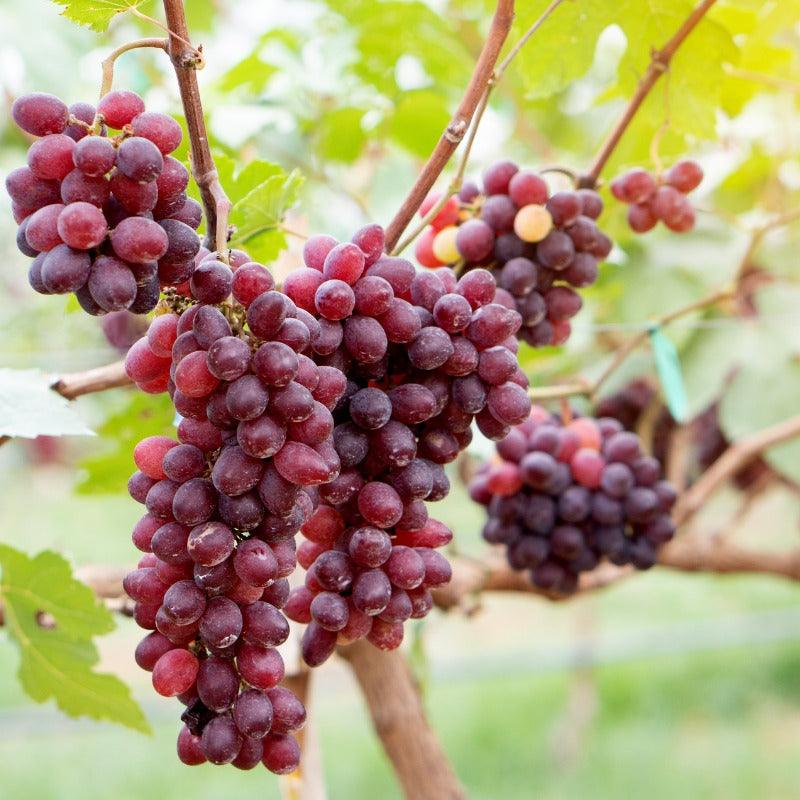
Can’t wait to see how these grow! They arrived looking very healthy and were larger than I thought they would be.
Videos
Articles
-
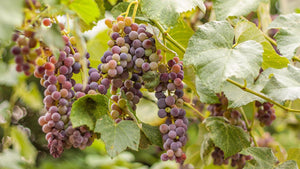 Sun, Jan 07, 2024
Sun, Jan 07, 2024Planting & Growing Grapes
-
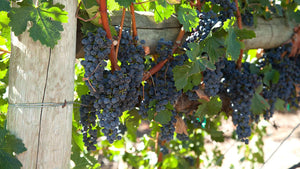 Wed, Mar 12, 2025
Wed, Mar 12, 2025When to Plant Grapes: A Complete Guide to Planting Grapes in Clay Soil and Beyond
-
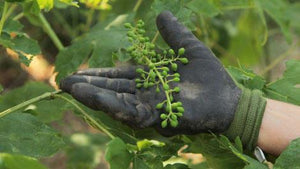 Thu, Jul 03, 2025
Thu, Jul 03, 2025Trim Grapes in Summer With Confidence: Learn How to Trim Grape Vines in Summer and the Secrets to Pruning Grape Vines During Growing Season
-
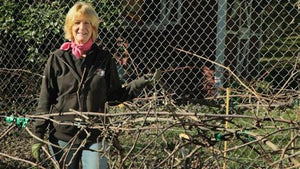 Thu, Feb 06, 2025
Thu, Feb 06, 2025Planting & Pruning Grape Vines

